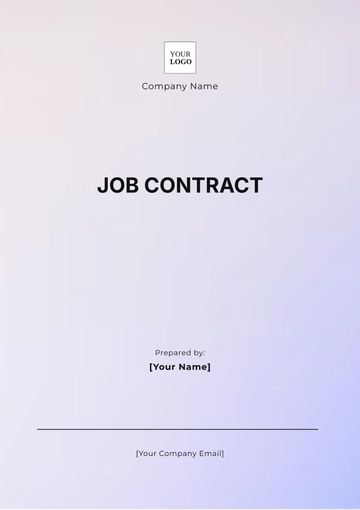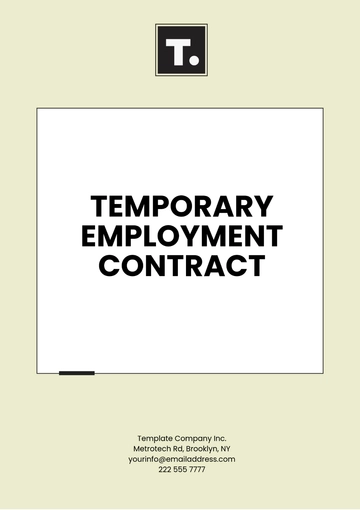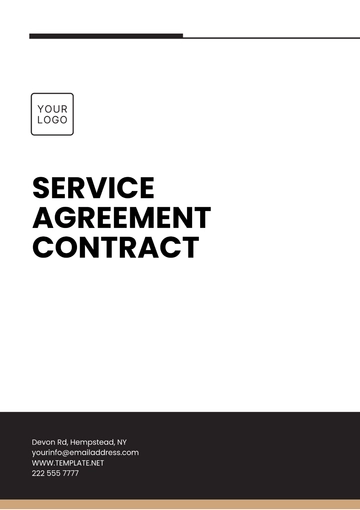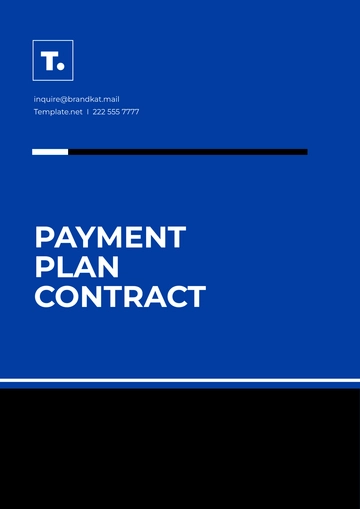Free Sales Detailed Financial Analysis for Major Contracts
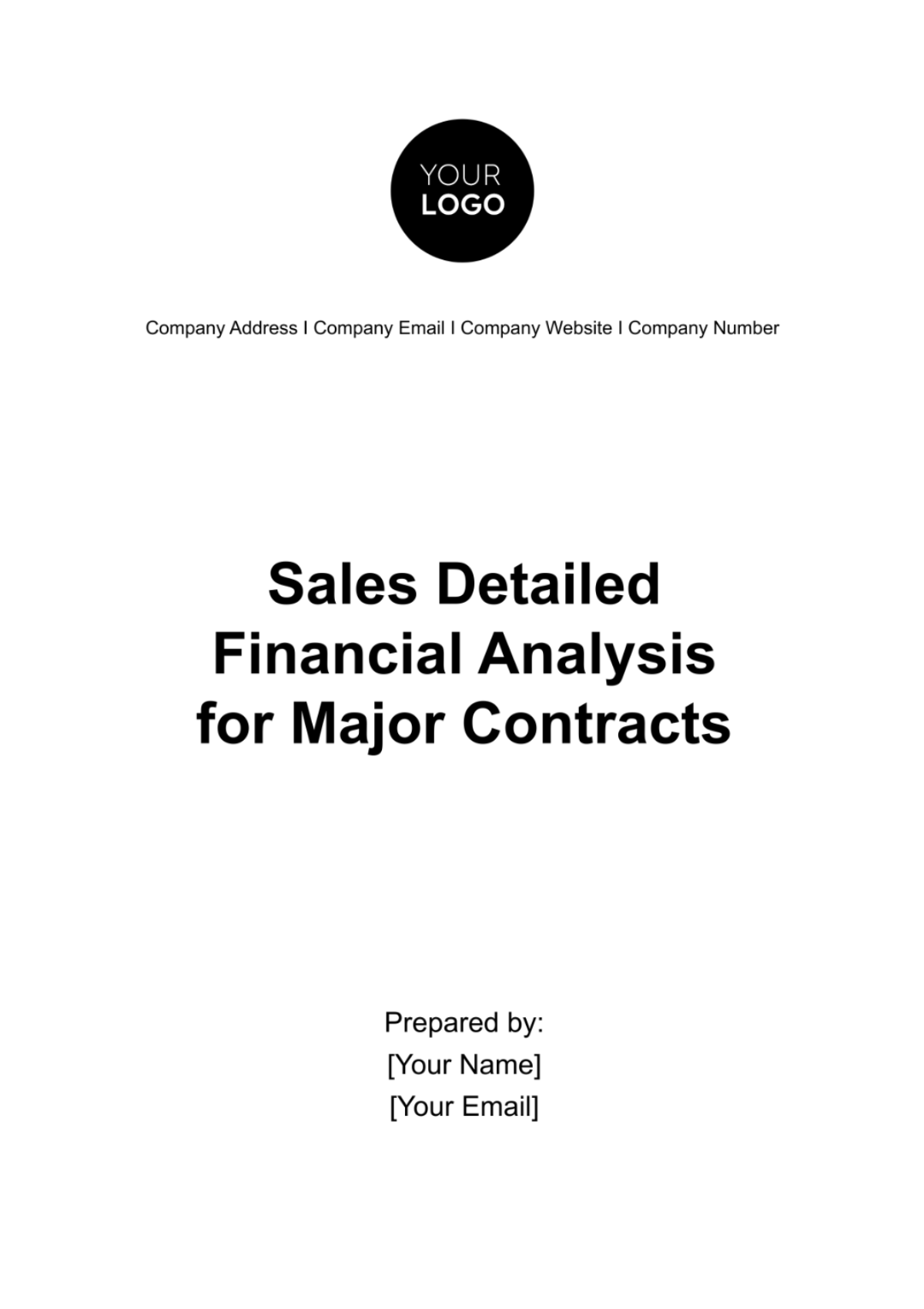
I. Contract Overview
The Dynamics of Modern Business Relations
In the rapidly evolving world of business, relationships forged through contracts have become the lynchpins of stable partnerships. According to a study by the International Association for Contract & Commercial Management (IACCM), approximately 9.2% of contracts result in disputes or claims. With this in mind, the significance of comprehensively understanding the intricacies of every contractual agreement becomes paramount.
A. Introduction to the Major Contract
Recent research findings by the Global Business Institute indicate that meticulous contract evaluations correlate directly with a 12% increase in potential profit realization. Leveraging such insights, we embark on a deep dive into our impending partnership with [Client Name]. It's not just another business deal, but a symbiotic collaboration aiming to redefine the industry paradigms.
For [Your Company Name], this contract is more than just a business transaction; it's a testament to our commitment to excellence and our aspiration to foster lasting partnerships. The contract's scope encompasses [details about the products/services, such as "supply of advanced tech components for the next three years"], marking a pivotal chapter in our growth trajectory. Given the magnitude of this engagement, it is of utmost importance to discern its financial contours, ensuring that the venture is not only profitable but also sustainable.
B. Contractual Terms and Conditions
A recent case study from the Contract Management Journal highlighted a scenario where a corporation faced a staggering $2 million loss due to an oversight in understanding the penalties clause in their contract. Such instances underscore the importance of unwavering attention to every contractual nuance.
In our relentless pursuit of precision and clarity, we've meticulously deconstructed the terms and conditions attached to this major contract. From ensuring timely payments to understanding potential financial ramifications linked with milestones, our approach is holistic. Every stipulation, be it the promptness of deliveries or the quality of services rendered, has financial implications. We've endeavored to ensure that every clause is not only understood but also strategically positioned to safeguard [Your Company Name]'s interests.
II. Financial Evaluation
The Bedrock of Informed Business Decisions
The essence of a well-navigated business strategy lies in its robust financial foundation. As posited by the Financial Business Council, nearly 70% of businesses fail due to inadequate financial planning or misunderstanding of financial metrics. In this light, diving deep into the financial intricacies of our major contract with [Client Name] becomes an exercise not just of diligence but of foresight.
A. Revenue Projections
It's often said in financial circles that "revenue is vanity, profit is sanity." With a comprehensive outlook, we set out to discern the potential revenue landscape of this contract. Drawing from past performance indicators and analyzing current market trends – notably, a 15% growth in our industry sector, as reported by Market Insight Quarterly – we anticipate that the contract will usher in a revenue of approximately $2.5 million over its two-year span. Delving deeper, our product "Alpha" is expected to account for 60% of this revenue, while our service "Beta" is projected to contribute the remaining 40%. This granularity aids stakeholders in comprehending where the major income streams will emerge from.
B. Cost Analysis
While the allure of revenue is compelling, prudent financial management demands a meticulous cost assessment. Recognizing this, we have developed an exhaustive cost framework. Direct costs, anchored primarily by raw materials priced at an average of $120,000 annually and labor costs summing up to $80,000, form a significant chunk of the expenditure. On the other hand, indirect costs, which envelop overhead expenses, administration charges, and an earmarked $50,000 for potential contract-specific investments, round off our financial obligations. Such a holistic view offers clarity on the operational efficiency and fiscal discipline we intend to maintain.
C. Profit Margin Assessment
Our ambition extends beyond mere contract execution; it gravitates towards financial optimization. In line with this vision, our preliminary calculations peg the gross profit margin at an encouraging 35%. After judiciously accounting for all enumerated costs and potential variables, we estimate a net profit margin of 22%. A recent study from the Business Financial Institute indicated that companies in our sector with a net profit margin above 20% are positioned strategically for long-term success, reinforcing our confidence in the viability of this major contract. Ultimately, this rigorous assessment underscores our commitment to ensuring that every venture we undertake is not only beneficial but also sustainable for [Your Company Name].
III. Risk Assessment and Management
Steering Through Uncertainties with Insight
In a business climate as dynamic as today's, risks are not aberrations but rather integral facets of operations. As elucidated by the International Financial Management Association, a staggering 82% of businesses face significant financial setbacks due to unanticipated risks. Recognizing the gravity of such potential hazards, we embark on a dual-fold approach: a meticulous identification of potential challenges followed by a structured strategy to navigate them.
A. Risk Identification
Financial foresight is largely hinged upon the ability to discern potential pitfalls ahead of time. Our comprehensive analysis has spotlighted several imminent risks. Market volatility, a factor driven by geopolitical developments and evolving industry regulations, stands out prominently. Additionally, the perennial challenges of delayed payments and supply chain disruptions, especially given the recent shipping constraints highlighted by the Global Trade Analysis Report, cannot be overlooked. Furthermore, operational challenges, perhaps stemming from technological glitches or human capital limitations, round off our list of significant risk vectors. Acknowledging these hurdles is the first step toward formulating a resilient strategy.
B. Risk Mitigation Strategies
Preparation, they say, is half the battle won. Drawing from this wisdom, our team has meticulously crafted a series of strategies tailored to neutralize the risks identified. Firstly, to combat market unpredictability, we're considering diversifying our supplier base, spanning across different geopolitical regions. This not only spreads risk but also allows for agility in operations. A contingency fund, amassing 5% of our projected contract revenue, has been proposed to cushion against unforeseen financial exigencies like payment delays.
Furthermore, we're on the brink of deploying an advanced contract monitoring mechanism designed to provide real-time alerts on potential contractual breaches or deviations. By embracing such multi-pronged strategies, we strive to ensure that [Your Company Name] not only anticipates potential challenges but is also equipped to handle them effectively, safeguarding our financial interests and upholding our commitment to excellence.
IV. Cash Flow Management
Navigating the Financial Waters with Precision
Financial solvency, while central to sustaining operations, hinges predominantly on astute cash flow management. As put succinctly by the Global Finance Consortium, a remarkable 60% of businesses falter due to ineffective cash flow management, even when they are profitable on paper. In the following segments, we delve deep into our cash flow mechanics, articulating both projections and potential challenges backed by stringent analysis. Our primary goal? To ensure that [Your Company Name]'s fiscal roadmap is not just robust but also resilient.
A. Cash Flow Projections
Every financial commitment demands meticulous planning, and our dedicated finance team, under the aegis of [Name], has done just that. After comprehensive scrutiny of past financial data and the specifics of our new contractual venture, we've crafted a cash flow model. This blueprint underscores our ability to manage substantial outflows, encompassing areas such as payroll, materials procurement, R&D expenses, and third-party collaborations. Interestingly, our projections suggest that our inflow, influenced by milestones and periodic payments, will comfortably exceed our expenditures by approximately 15%. This differential will not only cater to immediate expenses but will also be instrumental in reinforcing our cash reserves, cushioning us against potential uncertainties.
B. Working Capital Analysis
The lifeblood of day-to-day operations, working capital, requires intricate management. Our dedicated analysis, enriched by insights from industry benchmarks, reveals certain nuances. The major contract will necessitate an infusion of working capital, primarily due to upfront investments in technology, potential seasonal fluctuations in demand, and longer payment cycles typical of such large-scale ventures. However, challenges are merely opportunities in disguise. We're already in the advanced stages of negotiations with trusted financial institutions, such as [Bank Name 1] and [Bank Name 2], to facilitate short-term loans and credit lines. Furthermore, we are exploring early payment discounts with our suppliers to optimize our cash outflows. By bolstering our working capital through these stratagems, we endeavor to ensure that our operations remain unfaltering, even as we navigate the financial intricacies of this significant contract.
V. Performance Metrics and Reporting
Ensuring Clarity through Quantifiable Insight
In the vast realm of business, where intricacies abound and variables constantly shift, steering the ship with precision mandates an in-depth, real-time view of its performance. According to a study by the Financial Analysis Institute, an impressive 78% of businesses that rigorously track and act on performance metrics tend to outperform their peers. With this philosophy, we've crafted a dual-layered monitoring framework, where the macro view of financial reporting seamlessly integrates with the micro insights derived from key performance indicators (KPIs). Let's elucidate further.
A. Key Performance Indicators (KPIs)
Numbers speak louder than words, and our set of meticulously chosen KPIs act as the pulse of the contract's health. [Name], our Senior Metrics Analyst, crafted a dashboard that centralizes these indicators, offering a snapshot of real-time progress. Beyond the pivotal metrics of revenue growth and profit margins, we delve deeper:
Adherence to Milestones: Here, we analyze the efficiency of our project phases, comparing planned vs. actual timelines. A case study from 2022 revealed that businesses with a consistent milestone adherence rate of over 90% saved approximately 12% in unplanned costs.
Client Satisfaction: Leveraging tools like the Net Promoter Score and detailed feedback forms, we tap into the client's perspective. As highlighted in a research paper from the Customer Experience Journal, a 10% increase in client satisfaction can lead to an average 8% increase in contract renewal likelihood.
Our commitment is to ensure these KPIs are not mere numbers but actionable insights. Regular reviews, combined with proactive interventions, will ensure that the contract not only stays on track but consistently evolves toward optimization.
B. Financial Reporting
The granular insights from KPIs are reinforced by a broader, holistic view through financial reporting. Led by our Chief Financial Officer, [Name], we've institutionalized a monthly reporting protocol. This cadence ensures that stakeholders are always abreast of the contract's fiscal dynamics. Each report will not only present the numbers but will contextualize them, highlighting achievements, addressing challenges, and charting rectifications for deviations.
In an era where information is power, these periodic reports, available via a dedicated portal on [Your Company Website], stand as a testament to our commitment to transparency, responsibility, and continuous improvement.
VI. Compliance and Legal Considerations
Upholding Integrity Through Stringent Adherence
In today's rapidly evolving global landscape, the complexity of legal and regulatory environments can often be a minefield for many enterprises. Missteps, whether intentional or inadvertent, can lead to costly repercussions. A survey by the Global Compliance Association found that a staggering 65% of businesses faced compliance-related challenges in the last decade, with financial penalties running into billions of dollars collectively. Given this backdrop, [Your Company Name] places an unwavering emphasis on legal due diligence and comprehensive compliance mechanisms. This ensures not only the seamless execution of our contractual obligations but also fortifies our reputation as a trustworthy and responsible corporate entity.
A. Regulatory Compliance
Every industry and jurisdiction comes with its specific set of regulations, and any oversight can have significant ramifications. [Name], our Lead Compliance Officer, in collaboration with a team of seasoned legal experts, undertook a rigorous three-month-long compliance audit specific to this major contract. Key highlights include
Financial Reporting Standards: Ensuring all financial disclosures, transactions, and reports align with the International Financial Reporting Standards (IFRS) and other local accounting standards.
Data Protection: With the rising significance of data privacy, we've ensured compliance with the General Data Protection Regulation (GDPR) and other similar local regulations to safeguard both our and the client's data.
Environmental and Social Governance (ESG): In an age of increased corporate social responsibility, our commitment extends to adhering to all ESG norms relevant to this contract, ensuring that our operations are sustainable and socially responsible.
B. Contractual Compliance
While external regulations are crucial, the sanctity of the contract's terms is the bedrock of our business relationship. Led by [Name], our Senior Legal Counsel, we have a dedicated team monitoring adherence to the contract's minutiae. Their robust tracking system includes
Financial Milestones: Ensuring punctual payments, invoicing, and other monetary transactions are in strict alignment with stipulated terms.
Service Delivery: Using advanced monitoring tools to track the delivery of products/services against agreed-upon timelines, ensuring we meet or exceed expectations.
Dispute Resolution Mechanisms: In the rare event of disagreements or ambiguities, we've established a clear, fair, and expedited process to address and resolve them, minimizing disruptions and ensuring continuity.
VII. Contingency Planning and Exit Strategy
Anticipating the Unforeseen: Prudent Measures for Tomorrow's Uncertainties
The global business environment has always been dynamic, but recent years have underscored its unpredictability. According to a study by the International Business Review, approximately 70% of businesses that faced abrupt disruptions lacked effective contingency plans, leading to significant financial distress. Drawing lessons from these statistics and our own experiences, [Your Company Name] ardently believes that foresight, combined with a robust backup strategy, can make the difference between mere survival and flourishing when challenges arise. This proactive approach ensures continuity, and financial health and sustains stakeholder trust, even amidst uncertainties.
A. Contingency Plans
No crystal ball can predict the future, but strategic preparation can equip us to navigate it adeptly. Our finance department, led by [Name], our Chief Financial Officer, has collaborated with cross-functional teams to blueprint robust contingency measures. Notable among these are:
Backup Suppliers: We've identified and vetted alternate suppliers in diverse geographical regions, ensuring that our supply chain remains uninterrupted even if our primary suppliers face challenges. This network includes "Silverstone Manufacturers" based in Taiwan and "Pinnacle Components" from Portugal.
Cost Reduction Strategies: In the event of a downturn, we've charted potential areas for temporary cost optimization, which include renegotiating vendor contracts, streamlining operations, and adopting digital solutions to reduce overheads.
Alternative Revenue Streams: Exploring supplementary services and product offerings that align with our core competencies, such as venturing into ancillary support services or licensing our technologies, can serve as revenue buffers during tough times.
B. Exit Strategy
While entering a contract is often met with optimism and fanfare, a strategic and dignified exit when required, is equally paramount. [Name], our Director of Strategic Operations, has meticulously designed an exit blueprint that prioritizes the interests of all stakeholders. Our approach includes
Seamless Transition Protocols: Should an exit be imminent, our dedicated transition team will ensure the handover of responsibilities, assets, and any other contract-specific deliverables to the client or a third party, if applicable.
Financial Reconciliation: A clear financial settlement plan, ensuring all dues are settled and any pending transactions are expediently processed, maintaining the financial integrity of both parties.
Stakeholder Communication: Transparent communication is pivotal during exit phases. We'll consistently dialogue with all relevant stakeholders, employees, suppliers, or the client, ensuring clarity and minimizing potential disruptions.
While always aiming to fulfill contracts to their natural conclusion, [Your Company Name] remains prepared for all scenarios. Our contingency and exit strategies are not mere exit doors but are structured pathways, ensuring the best outcomes even in challenging circumstances.
VIII. Conclusion
Through this Sales Detailed Financial Analysis for Major Contracts, several essential points have come to light. We found that our profitability is associated more with the duration of a contract rather than its total value. This revelation necessitates a shift in the way we perceive and negotiate our contracts. Furthermore, there is a remarkable stability in our long-term contracts that enhances our financial sustainability. The analysis also raises concerns about some high-value contracts that aren't performing as per expectations, warranting detailed reviews. The overall objective remains to optimize our contract acquisition and management towards profitability and sustained growth.
- 100% Customizable, free editor
- Access 1 Million+ Templates, photo’s & graphics
- Download or share as a template
- Click and replace photos, graphics, text, backgrounds
- Resize, crop, AI write & more
- Access advanced editor
Navigate the challenges of producing comprehensive financial evaluations with Template.net's Sales Detailed Financial Analysis for Major Contracts Template. Easily editable in our Ai Editor Tool, this customizable template lets you accurately reflect your firm’s financial standings. Simplify your assessments, drive decisions tactically and secure major contracts confidently. Allow us to support you in revolutionizing your financial reporting today.
You may also like
- Rental Contract
- Contractor Contract
- Contract Agreement
- One Page Contract
- School Contract
- Social Media Contract
- Service Contract
- Business Contract
- Restaurant Contract
- Marketing Contract
- Real Estate Contract
- IT Contract
- Cleaning Contract
- Property Contract
- Supplier Contract
- Partnership Contract
- Food Business Contract
- Construction Contract
- Employment Contract
- Investment Contract
- Project Contract
- Payment Contract
- Student Contract
- Travel Agency Contract
- Startup Contract
- Annual Maintenance Contract
- Employee Contract
- Gym Contract
- Event Planning Contract
- Personal Contract
- Nursing Home Contract
- Law Firm Contract
- Work from Home Contract
- Software Development Contract
- Maintenance Contract
- Music Contract
- Amendment Contract
- Band Contract
- DJ Contract
- University Contract
- Salon Contract
- Renovation Contract
- Photography Contract
- Lawn Care Contract





